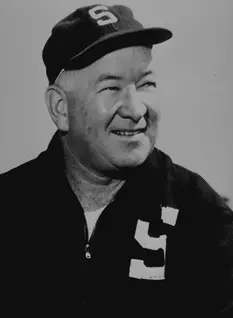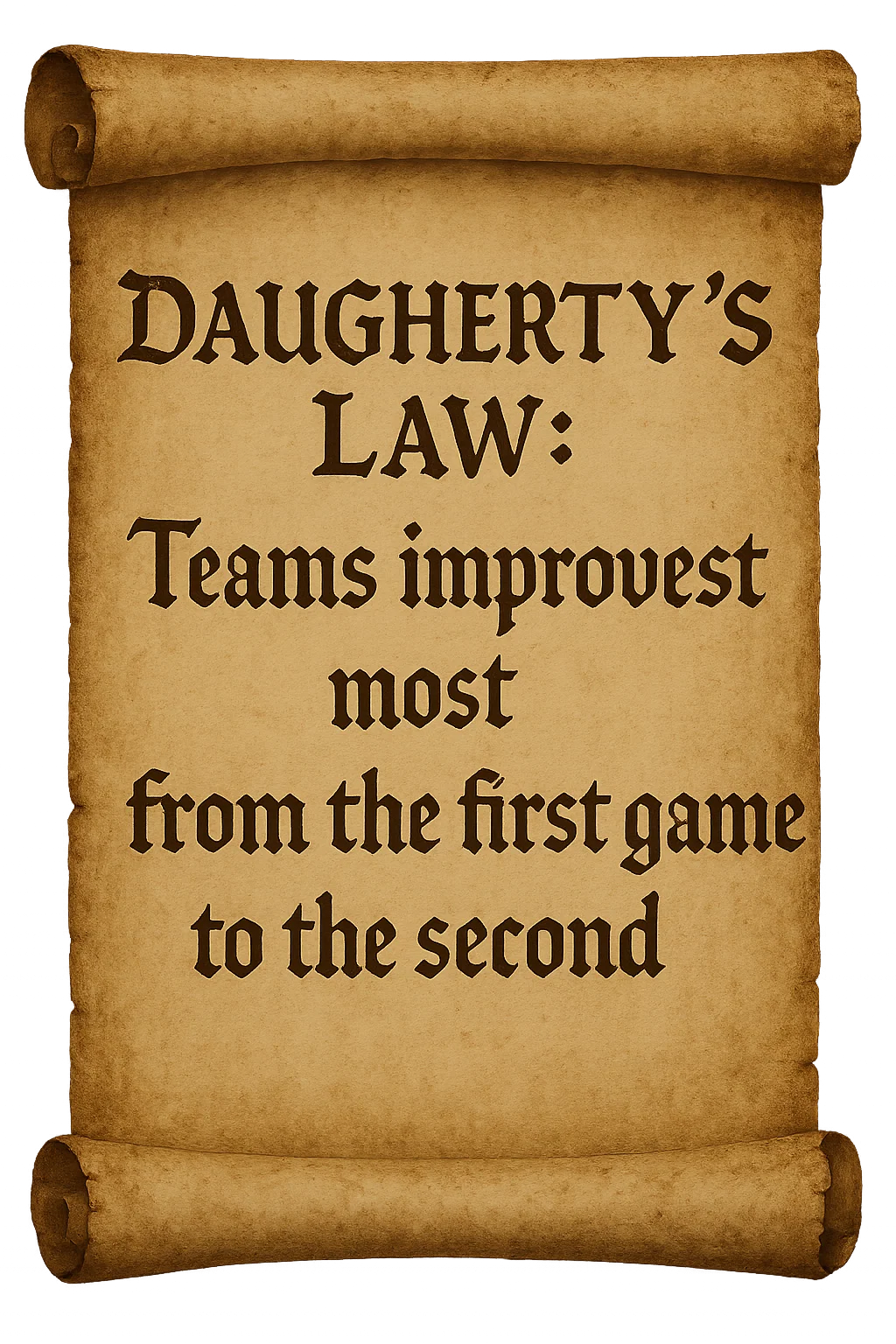First-To-Second Game Improvement aka Daugherty's Law
Most college teams played their first game of the season over the weekend, though a handful played during Week 0. With teams having a game under their respective belts, we will soon be in a position to assess one of football's great bromides, that teams see their greatest improvement between their first and second game of the season.
I searched for the origins of this supposed axiom, thinking it originated before leather helmets. However, I did not find any references to this line of thinking until the end of the leather helmet days, when Michigan State's Duffy Daugherty expounded on the notion when discussing his team opening against 1-0 Wisconsin, which had beaten Utah in their opener. Daugherty noted that Wisconsin's:
..already having played a game is a terrific advantage. The most improvement a football club shows in a season comes between the first and second game.
'Irate Coaches Face Openers,' Times (Hammond, IN), September 28, 1961.
Whether Daugherty's theory held true or not, the Spartans beat the Badgers 20-0 in Sparty's season opener, so that Wisconsin might have lost by a bigger score had they not improved based on Daugherty’s Law.

Two years later, MSU faced a similar situation when they opened against North Carolina, which had beaten Virginia the week before. Before the game, Duffy once again positioned the challenge facing his team, saying:
... they will have one game under their belt before they hit us. For the last five years we've been playing opening opponents with one-game experience. I always contend that a team improves 100 per cent (sic) from the first to the second game. This is where you iron out the mistakes.
'Michigan State Faces No "First 20" Pressure This Football Season,' Kalamazoo Gazette, September 1, 1963.
Daugherty's Law has floated around practice fields and coaches' offices ever since. The Law gets raised most often when a team that has yet to play meets another that has played one or two games. The application of Daugherty's Law peaked between 1985 and 1995 when the start of the football season crept earlier and earlier as early-season made-for-TV games for select teams became a thing.
Scientific laws are statements of observed phenomena and do not require theories to explain why they work; the law simply states that things work in a certain way. Nevertheless, a review of stories related to Daugherty's Law reveals five patterns.
The Aggrieved Martyr Model
My favorite pattern is exemplified by two practitioners who got more mileage out of the woe-is-me model than anyone else: Earle Bruce and Bo Schembechler. Despite having every advantage in the world, they saw the world through Captain Queeg's eyes: everyone was out to get them.
Earle Bruce became angry in 1985 when the TV boys moved Pitt's game versus Purdue ahead in the schedule. The Panthers' nationally-televised, 31-30 win over the Boilermakers led Bruce to proclaim.
I think it's lousy that under the rules anybody can get a head start. It gives Pitt a tremendous advantage. They have had 40 practices to 20 practices for us in addition to having played a game. The greatest improvement of a team comes between the first and second game of the season.
'Bruce Angered By Panthers Early Game,' Victoria Advocate (TX), September 11, 1985.
Ohio State won the home game against Pitt 10-7. Ohio State finished 9-3 while Pitt finished 5-5-1.
Bo Schembechler claimed his 1987 Michigan Wolverines were put at a severe disadvantage when Notre Dame had their contest with Virginia moved up for television. Then, Lou Holtz doubled down by refusing to give Michigan film of the Virginia game. Bo expressed his views, saying:
...we are going into that game at a disadvantage. Since August 7 Notre Dame has been practicing football. We were in our second day of pads (full-contact practice) and Notre Dame was playing their first game. That's how far behind we are. Then they have two weeks off before they play us, and it's a fact that you're (sic) greatest improvement as a team comes between your first and second game.
'Bo Denied Look At Notre Dame,' Ann Arbor News, September 3, 1987.
Notre Dame beat Michigan 26-7. Both teams finished 8-4,
Speaking of Lou Holtz, during his tenure at Arkansas 10 years earlier, he told reporters that Vince Dooley had shown him a report indicating that teams playing their second game win 75% of the time against teams playing their first game of the season. The article did not mention whether Dooley's study controlled for whether or not the coach who had already played shared film of that game, and I found no other reference to the Dooley Report.
Create Your Future Postulate
Woody Woodenhover, Missouri's coach in 1987, laid out an interesting theory following the Tigers' 28-13 season-opening win over Baylor. Woody Woodenhover claimed:
If a team is going to be any good, it shows its greatest improvement from the first game to the second. If we are going to have a decent team, it's going to be because of how much we improve from now until Saturday.
'Sidelines,' Columbia Daily Times, September 16, 1987.
Mizzou beat Northwestern the following week before finishing 5-6 on the year.
Another coach on the prairies, Bill Snyder, espoused the teams create their future theory in 1999 before Kansas State's opener against Temple, when the Owls had already played a game. However, after KSU beat Temple, he reversed the script as they prepared for Texas-El Paso:
All I've told our team is, it depends on what they do, whether that is true or not. They have control over whether they become a better football team or a better player individually. It doesn't happen automatically.
'Snyder Hopes 'Cats Can Make Strides vs. UTEP,' Salina Journal, September 18, 1999.
That was some fine motivational coaching. Syndee presented Temple as a challenge since the Owls would automatically improve by having a game under their belts, but told his team that it was up to them. They had to work hard to improve after beating Temple.
True Believerism
Some coaches among us fervently believe in Daugherty’s Law. Take, for instance, Dennis Erickson, who, while at Oregon State in 2001, expressed concern about their opener with Fresno State, given that FSU would play Colorado before meeting the Beavers.
I've always said the greatest improvement is between the first and second game, so that's an advantage for (Fresno State).
'Beavers Start Preparing For Fresno State,' Albany Democrat-Herald (OR), August 14, 2001.
While we don't know if Erickson had always said that, he had said it in the past. He said it in 1990 after his #1 Miami Hurricanes lost at BYU in the opener, when BYU had already played a game. He also expressed concern in 1992, when his No. 1 Miami team opened at No. 23 Iowa, which was 1-0. Miami won 24-7 and finished 11-1.
The Week Two Opponent Exception
The fourth grouping involves those who pay more attention to their Week Two opponent than to Daugherty’s Law. Ara Parseghian said he was not big on the improvement theory since Notre Dame often played Purdue in Week Two, a team they struggled to beat. Rice coach Ray Alborn generally bought into the theory, but they played Texas in Week Two in 1978, so the theory flew out the window as the Longhorns tossed the Owls around like, well, owls.
The Malarkey Skeptics
A subset of coaches are skeptics who consider Daugherty’s Law to be nonsense. Iowa's Hayden Fry called it a fairy tale, noting in 1989: "It could be that we'll be improved, or we could be worse."
Not to be outdone was George Perles, who played for Duffy Daugherty, the Law’s originator at Michigan State. Perles later became head coach at MSU, rejecting the Law’s effect on their 1991 opener with Central Michigan, which had played two games before meeting Sparty.
I can't say if that's good or bad until after the game. If we beat them, it won't mean anything. If we don't it will be an excuse.
'MSU Expects To Face Fired Up Chippewas,' Saginaw News, September 13, 1991.
So, there you have it. Since the scientific community or even the sports data geeks have not investigated Daugherty's Law, we can interpret the views of the coaches cited above as we wish and believe anything we want. Here's to Daugherty's Law working in your team's favor and being a load of malarkey for your opponents.
Football Archaeology is reader-supported. Click here to buy one of my books, donate, or otherwise support the site.



Of course, UNC lost the game mentioned 31-0. I don't know how that 3-game series against MSU came about, but of note were the African-American Spartans from North Carolina. I think that story is on the web somewhere and I have scant knowledge of the details.
I can only hope my team improves after it's first game.